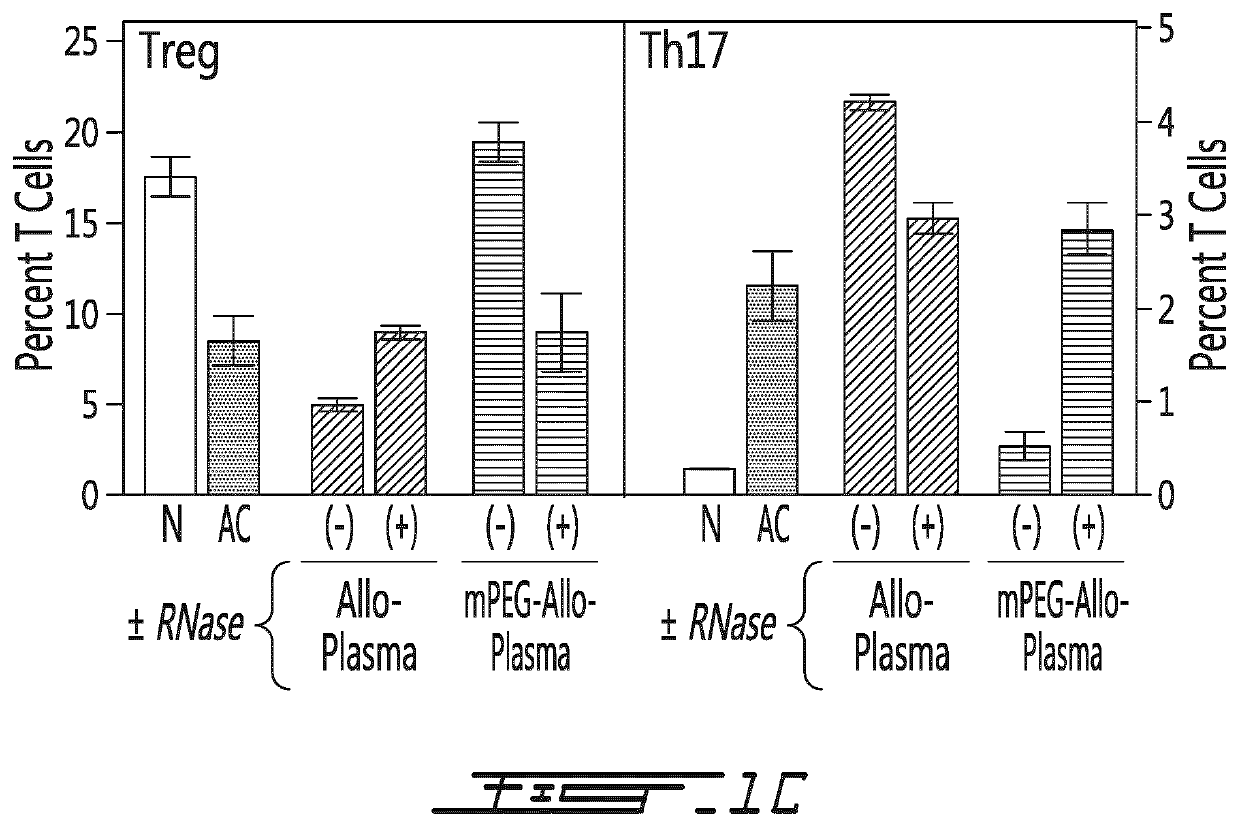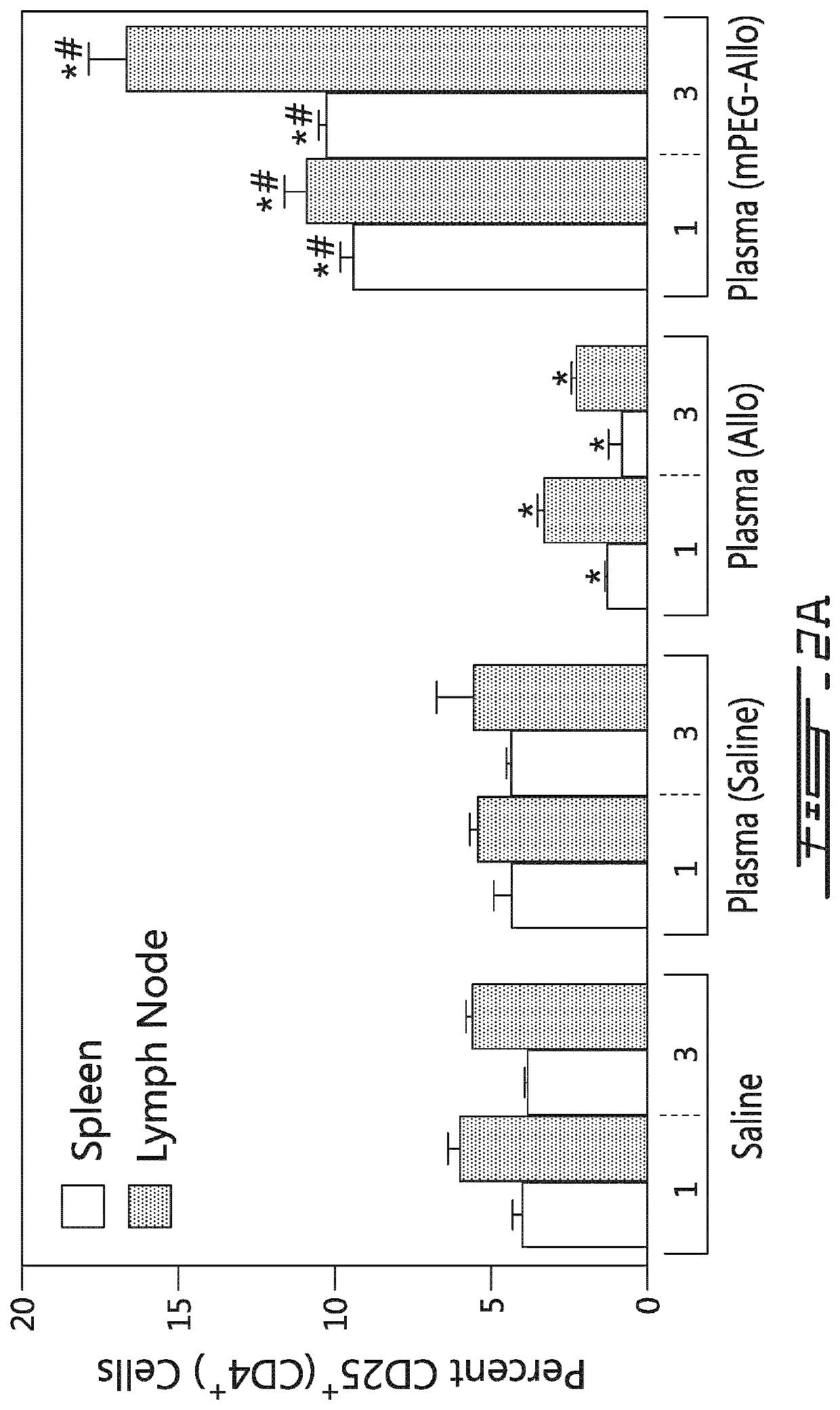Acellular pro-inflammatory compositions, process for making same and methods of using same
a technology of pro-inflammatory compositions and acellular components, applied in the field of acellular-based preparations, can solve the problems of limited direct specificity towards cancer cells, high cost of approach, and significant morbidity and mortality, and achieve the effects of increasing pro-inflammatory t cell levels, decreasing treg levels, and decreasing the ratio of levels
- Summary
- Abstract
- Description
- Claims
- Application Information
AI Technical Summary
Benefits of technology
Problems solved by technology
Method used
Image
Examples
example i
Material and Methods
[0121]Human PBMC and Dendritic Cell Preparation.
[0122]Human whole blood was collected in heparinized vacutainer blood collection tubes (BD, Franklin Lakes, N.J.) from healthy volunteer donors following informed consent. PBMC were isolated from diluted whole blood using FicollePaque PREMIUM™ (GE Healthcare Bio-Sciences Corp, Piscataway, N.J.) as per the product instructions. The PBMC layer was washed twice with 1× Hank's Balanced Salt Solution (HBSS; without CaCl2 and MgSO4; Invitrogen by Life Technologies, Carlsbad, Calif.) and resuspended in the appropriate media as needed for mixed lymphocyte reactions and flow cytometric analysis of Treg and Th17 phenotypes. Dendritic cells (DC) were prepared from isolated PBMC as described by O'Neill and Bhardwaj (O'Neill et al., 2005). Briefly, freshly isolated PBMC were overlaid on Petri dishes for 3 h in AIM V serum free culture medium (Invitrogen, Carlsbad, Calif.). Non-adherent cells were gently washed off the plate. The...
example ii
Characterization of Conditioned Plasma Obtained from Administering Non-Polymer Grafted Lymphocytes
[0155]The material and methods used in this example are provided in Example I.
[0156]In a first series of experiment, several types of conditioned plasma were obtained. Briefly, the conditioned plasma was first obtained from Balb / c mice having received saline, 20×106 allogeneic (C57BL / 6) PEGylated splenocytes (using 1 mM 20 kDa PEG) or 20×106 allogeneic (C57BL / 6) unmodified splenocytes. The conditioned plasma was either left untreated (e.g. complete) or fractionated in function of the size of its components (>100 kDa, between 30 and 100 kDa, between 10 and 30 kDa or <10 kDa). The saline of the treated conditioned plasma was then transfused to naïve C57BL / 6 mice. Five days after the administration, the animals were sacrificed, the spleen was obtained and the cells they contained was characterized. As shown on FIG. 1A, the <10 kDa fraction of the conditioned plasma from mouse having receiv...
example iii
Characterization of miRNA Preparations Obtained with Non-Polymer Grafted Lymphocytes
[0160]The material and methods used in this example are provided in Example I.
[0161]The conditioned plasma or the miRNA preparation (100 μL) obtained from the conditioned plasma (of mice having received saline, unmodified allogeneic splenocytes or polymer-modified allogeneic splenocytes) were administered intravenously to 7-8 week-old mice thrice (at days 0, 2 and 4). Cohorts (n=4) of mice were sacrificed at days 30, 60, 120, 180 and 270. Spleens were removed and CD4+ cells were stained for intracellular expression of IL-2, IL-4, IL-10, INF-γ and TNF-α. Splenic Treg and Th17 populations were also measured. As shown on FIGS. 4A-C, the administration of the conditioned plasma or the derived miRNA preparation (i.e., IA1 preparations) from mouse having received unmodified allogeneic splenocytes caused an increase in the expression of intracellular IL-2 and INF-γ in CD4+ cells. On the other hand, the admi...
PUM
| Property | Measurement | Unit |
|---|---|---|
| average molecular weight | aaaaa | aaaaa |
| molecular weight | aaaaa | aaaaa |
| average molecular weight | aaaaa | aaaaa |
Abstract
Description
Claims
Application Information
 Login to View More
Login to View More - R&D
- Intellectual Property
- Life Sciences
- Materials
- Tech Scout
- Unparalleled Data Quality
- Higher Quality Content
- 60% Fewer Hallucinations
Browse by: Latest US Patents, China's latest patents, Technical Efficacy Thesaurus, Application Domain, Technology Topic, Popular Technical Reports.
© 2025 PatSnap. All rights reserved.Legal|Privacy policy|Modern Slavery Act Transparency Statement|Sitemap|About US| Contact US: help@patsnap.com



